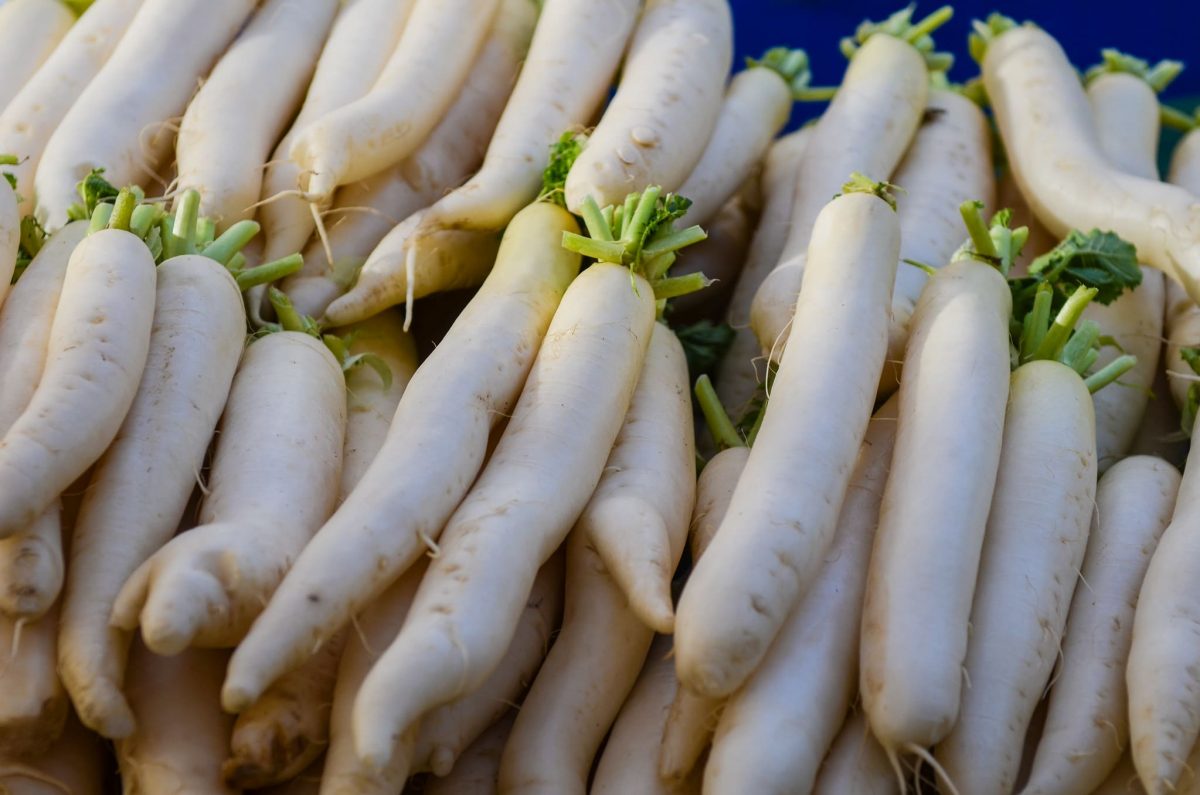All products are independently selected by our editors. If you buy something, we may earn an affiliate commission.
Whenever I bite into a hot, crunchy piece of Korean fried chicken, I first shed one tear of joy, then immediately look for its well-suited chaser: pickled daikon radish. Those crispy, garlicky, soy-glazed wings are just not complete without the cool, tart, and sweet snap of pickled radishes. But what is daikon, exactly? Get to know this nutritious, crunchy, refreshing vegetable, and learn how to use it in a plethora of ways, from soups and stews to stir-fries, kimchi, and banh mi sandwiches.
Daikon is a long white root vegetable grown throughout East and South Asian countries. It sort of resembles an extra-extra large carrot and, like many radish varieties, it’s nutritious, crunchy, refreshing, and takes on different consistencies and flavors depending on how it’s cooked.
The word daikon is Japanese: Dai means “big” or “great”; kon means “root.” Combined, this translates to…well, “big root.” Its rounder Korean cousin is named mu. Another close relative, the vibrantly hued watermelon radish, originated in China. In Cantonese, daikon is called lo bak. The Mandarin equivalent is luo bo—but in some parts of China, daikon radishes are actually called turnips. In South Asian countries, daikon is often called mooli. And because daikon can withstand cold temperatures, the crop is sometimes referred to as winter radishes.
Daikon and red radishes are related, but they have some major differences. For instance: Taste: Daikon radishes, which have a subtly sweet flavor, are milder than peppery red radishes. Size, shape, and color: White, oblong daikon radishes are roughly the size and shape of short, chubby carrots.

Does daikon have any health benefits?
An ancient Chinese proverb says, “When white radishes are in season, doctors should take a break.” Translation: Daikon is a dietary superstar. It’s a low-calorie food with high water content and its packed with vitamins and nutrients, including vitamin C, calcium, folate, and potassium. Daikon also contains fiber and enzymes that aid digestion. Daikon consumption is sometimes recommended for pregnant women because of the vegetable’s high folate content, which is reported to help with cell growth and development.
What’s the difference between daikon and red radishes?
Daikon and red radishes are from the same genus and species. They differ primarily in color, size, and where they are typically grown and consumed.
Daikon radishes can grow up to 20 inches long and are mostly white, although some varieties like the Korean mu have light green coloring near their leaves. Red radishes tend to be spicier, max out at about two inches in diameter, and are more commonly consumed in Western cuisines.
If you can’t find daikon radishes in your local grocery store or farmers market, the next best thing is jicama. Also a root vegetable, jicama has a similarly crisp, watery bite and starchy mouthfeel. While its sweet flavor differs from daikon, texturally jicama is the best option.
If your grocer’s shelves are equally jicama-less, then the trusty hothouse or English cucumber would be your next best bet for dishes or recipes that call for raw daikon. You can also try substituting other radish varieties, like white or red radishes.
What’s the difference between mu and daikon?
FAQ
Can I substitute radish for daikon?
Does daikon radish taste the same as red radish?
Which is the healthiest radish?
Why do you use daikon radishes?
What is the difference between daikon and radishes?
Daikon is a winter radish with a milder, sweeter taste. Radishes are generally spicier and can be eaten raw in salads. Daikon is larger and white, often used in Asian cuisines. Both vegetables are nutritious, but daikon has more vitamin C. Radishes can substitute daikon in some dishes, but flavors differ.
What is the positive impact of radishes?
Radish has benefits for liver function and cardiovascular health. Radishes are rich in minerals and antioxidants which help to reduce the risk of heart disease and lower blood pressure.
Is daikon radish healthy?
Daikon radish is a nutritious, low-calorie cruciferous vegetable that may promote your health in various ways. Eating it may help you maintain a healthy body weight and protect against chronic conditions, such as heart disease and certain cancers. Daikon is not only an exceptionally healthy vegetable but also incredibly versatile.
Is Korean radish sweeter than daikon?
So here is a quick breakdown of two related vegetables – Korean radish and daikon. Though they are both parts of the radish family, daikon is much sweeter than Korean radish. Daikon remains just as sweet when cooked, whereas Korean radish loses its limited sweetness the longer it is cooked. What is Korean Radish?
